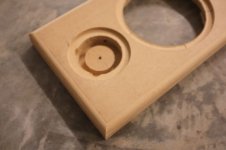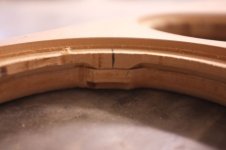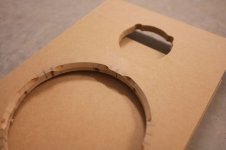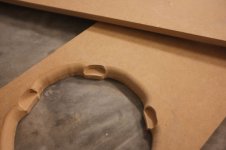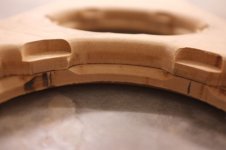Dave will hopefully be installing drivers (which by my estimate will have more mass than the initial boxes)
Considerably heavier
dave
Easy to get carried away with the cabinet and forget the crossover is 90% of the results.
90% x zero (in most cases for us) = zero.
dave
How would a cavity resonance manifest itself with the sound or freq response measurement? Would 7" driver in a 6" opening cause an anomaly at 13560/6= 2250hz or so? Or is it higher in frequency because the driver itself is in the middle of the cavity with the magnet/cone reflecting to the wall 2" away? I would imagine its higher up in frequency than the driver operates in a 2 or 3 way. Full range would likely have more issues.
How would a cavity resonance manifest itself with the sound or freq response measurement? Would 7" driver in a 6" opening cause an anomaly at 13560/6= 2250hz or so? Or is it higher in frequency because the driver itself is in the middle of the cavity with the magnet/cone reflecting to the wall 2" away? I would imagine its higher up in frequency than the driver operates in a 2 or 3 way. Full range would likely have more issues.
I was just repeating the mantra of the designer.
I can visualize a conical opening on the back of a woofer projecting energy to the back wall in a different way than a mitered <to the back> baffle.
P
Post more pictures.
Here's the baffles after a bit more work. I've done the front and back panels separately, as I can't get any larger bits than 10mm chamfer and 12mm roundover for my el-cheapo 1/4" router. The back panel doesn't look as good as I want it to. It's currently rounded, while the front panels is chamfered.
Should I redo the back panel (could go for 12mm plywood if I did), to make the chamfer properly align with the chamfer on the front panels? Or should I simply do some manual chamfering work, maybe adding a bit of putty to smooth things out?
I recessed the screw points a bit at the back, as I expect I need to cover the back of the screws with something to smooth out (eg. bitumen, or just putty?). Should I have left the full depth for the screws to bite in?
I haven't rounded over the front panel top corners, as I expect I won't round over the top side edges of the boxes. Is rounding over recommended here as well?
Lastly, I didn't cut fully through the holes for the tweeters, as they don't need the full depth of the baffle to fit. My thinking was that this insulates the tweeters a bit from the vibrations of the main chamber. But the thickness of the MDF left (about 8mm) might be too little. Would I be better off just sawing through the speaker holes completely?
Thank you for any advice!
Attachments
Here's the baffles after a bit more work. I've done the front and back panels separately, as I can't get any larger bits than 10mm chamfer and 12mm roundover for my el-cheapo 1/4" router. The back panel doesn't look as good as I want it to. It's currently rounded, while the front panels is chamfered.
Should I redo the back panel (could go for 12mm plywood if I did), to make the chamfer properly align with the chamfer on the front panels? Or should I simply do some manual chamfering work, maybe adding a bit of putty to smooth things out?
I recessed the screw points a bit at the back, as I expect I need to cover the back of the screws with something to smooth out (eg. bitumen, or just putty?). Should I have left the full depth for the screws to bite in?
I haven't rounded over the front panel top corners, as I expect I won't round over the top side edges of the boxes. Is rounding over recommended here as well?
Lastly, I didn't cut fully through the holes for the tweeters, as they don't need the full depth of the baffle to fit. My thinking was that this insulates the tweeters a bit from the vibrations of the main chamber. But the thickness of the MDF left (about 8mm) might be too little. Would I be better off just sawing through the speaker holes completely?
Thank you for any advice!
Yikes! The whole point of a router is that the same thing happens ALL around the hole.
Normally, a "tang" makes sure the router bit traces a hole.
Don't "bear" on the tang means drag the router gently after making sure the depth setting has your cut in mind.
P
Yikes! The whole point of a router is that the same thing happens ALL around the hole.
Normally, a "tang" makes sure the router bit traces a hole.
Don't "bear" on the tang means drag the router gently after making sure the depth setting has your cut in mind.
Which of the pictures are you referring to? I left the parts where the screws for the woofer sit un-routed / un-chamfered to allow them to bite properly in the MDF.
Last edited:
90% x zero (in most cases for us) = zero.
dave
I assume you are thinking about single driver systems ( here in the multi-way thread), but I would argue I have never seen/heard one done well without some amount of filtering, be it passive in the speaker or active (preferred) in the amp chain. I have never seen a driver of any kind that does not need any help.
There are several old sayings that have wisdom:
Don't over think the small stuff
Fix the biggest problem first
If the OP wants to go further than just knocking the sharp edge off with a rasp, then the only correct way to proceed is to make a series of baffles with different methods and measure to the differences. Round-over, bevel, cove, flair, and so on. Which is more important, lack of edge of total airflow?
As the OP has clearly said, his router can't spin a bigger bit, I recommend a wood rasp. It does not have to be pretty.
but it does have to be smooth.
Or should I say would it be smooth with a rasp?
On the baffle I'm using at present, I have used a 45degree chamfer still need to smooth the edges.
Next one I have a 28.6 dia 9.5 radius bit.
Last edited:
Found this relevant link;
Baffle Cutout Comparisons - Straight vs. Roundover vs. Chamfer Using Wideband Driver
It appears that chamfer is more optimal than rounding. I might just redo the back baffle panel in 9mm plywood and get it chamfered properly. Am suspecting that mdf/ply is a better sandwich than mdf/mdf in any case.
Baffle Cutout Comparisons - Straight vs. Roundover vs. Chamfer Using Wideband Driver
It appears that chamfer is more optimal than rounding. I might just redo the back baffle panel in 9mm plywood and get it chamfered properly. Am suspecting that mdf/ply is a better sandwich than mdf/mdf in any case.
Last edited:
- Status
- This old topic is closed. If you want to reopen this topic, contact a moderator using the "Report Post" button.
- Home
- Loudspeakers
- Multi-Way
- Baffle 36mm thick, do i need to chamfer?
